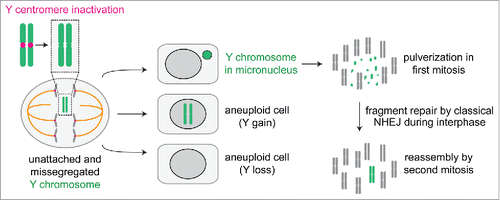Figures & data
Table 1. Summary of available tools and approaches to study cell division defects and/or chromosome segregation errors.
Figure 1. Swapping out CENP-A at the centromere with an inducible gene replacement strategy. Gene editing is first used to add an auxin-inducible degron (AID) sequence to endogenous CENP-A, which undergoes rapid TIR1 E3 ubiquitin ligase-dependent degradation in the presence of the plant hormone auxin. Degraded CENP-AAID is then rescued by a doxycycline-inducible gene encoding a CENP-A/histone H3 carboxy-tail chimera (CENP-AC-H3) that does not support kinetochore assembly specifically on the Y centromere, thereby producing Y chromosome-selective segregation errors in the subsequent mitosis.

Figure 2. A catastrophic fate for centromere-inactivated Y chromosomes. Following centromere inactivation using the CENP-A replacement strategy, the Y chromosome fails to properly congress during metaphase and subsequently missegregates in anaphase to produce aneuploid daughter cells with loss, gains, or micronucleation of the Y chromosome. When sequestered in a micronucleus, the Y chromosome undergoes extensive fragmentation in the next mitosis. The resulting fragments incorporate back into the nucleus for subsequent re-ligation by classical non-homologous end joining during interphase.

